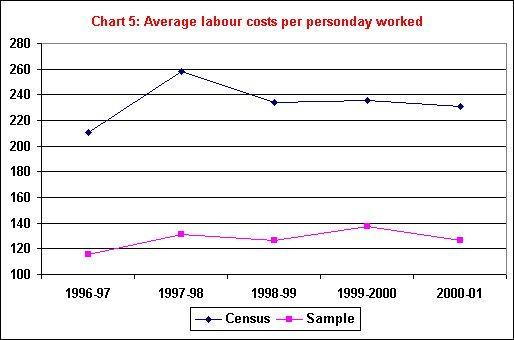The
belief is obviously that reducing such "rigidities"
and curbing the power of organised labour will increase
private investment, increase economic activity and
improve productivity. All these in turn will improve
external competitiveness, which is considered to be
so important these days.
The chief problem with this argument is that it completely
ignores the major forces affecting investment, economic
activity and therefore employment. It is now accepted
across the world that aggregate investment does not
respond to changes in the wage rate, but to broader
macroeconomic conditions such as the level of demand,
the amount of public investment, the expectation of
external markets, and so on.
Labour costs are never viewed in isolation, but only
in relation to labour productivity, which in turn
is affected not only by the level of well-being, skill
and education of the workers themselves, but also
by infrastructure conditions, the technology used
in production, and so on. In such a context, greater
"flexibility" in labour markets might simply
mean the perpetuation of low wage-low productivity
practices by employers, rather than more economic
growth.
While there is a formidable array of rights accepted
by the Indian Constitution for workers, and protective
legislation as well, the problem is that they are
rarely achieved or enforced. Typically they can only
be even minimally enforced in the organised sector.
It is currently being argued by neo-liberal economists
and others, that these laws, which restrict employers'
rights to dismiss workers at will and stipulate some
degree of permanency of employment, act as a major
drag on the profitability of the organised sector
and on its ability to compete with more flexible labour
relations elsewhere. In this perception, a shift towards
a more universal contract-based system of labour relations,
with no assumptions of permanency of employment, is
required to ensure economic progress based on private
enterprise within the current context.
But it can be argued in response to this, that labour
laws are far less significant as factors in affecting
private investment, and therefore employment, than
more standard macroeconomic variables and profitability
indicators. Thus, the condition and cost of physical
infrastructure, the efficiency of workers as determined
by social infrastructure, and the policies which determine
access to credit for fixed and working capital as
well as other forms of access to capital, all play
more important roles in determining overall investment
and its allocation across sectors. Expectations of
demand and the extent of the market determine the
volume of investment.
Indeed, it is also clear that in the recent past in
India, strikes have been far less relevant in disrupting
production in the Indian economy, than lockouts by
employers. Chart 1 shows the actual number of strikes
and lockouts in India over the period 1999-2002. While
both have been coming down over this period, the decrease
in the number of strikes has been more dramatic, and
in 2002, the number of lockouts was actually higher.

Chart
1 >> Click
to Enlarge
Chart 2 provides information on the number of workers
involved in strikes and lockouts - here, the evidence
is that strikes have involved a greater number of
workers than lockouts. However, obviously strikes
have been of shorter duration and therefore less disruptive
of production and economic activity, as shown by the
actual working days lost, in Chart 3. The persondays
lost to lockouts has been consistently higher than
the loss due to strikes, and was nearly double in
2002.

Chart
2 >> Click
to Enlarge

Chart
3 >> Click
to Enlarge
It is also likely that workers' discipline has improved
in general, as absenteeism rates among regular workers
seem to have come down quite drastically in the recent
past, as indicated in Chart 4. Similarly, labour costs
per personday worked (Chart 5) have been broadly flat,
despite large increases in labour productivity, so
that obviously workers have not garnered any advantage
from technological progress, the gain from which have
accrued to employers instead.

Chart
4 >> Click
to Enlarge

Chart
5 >> Click
to Enlarge
It is in this context that the right to strike must
be considered in India. Obviously, strikes are ultimate
weapons, which are only resorted to by workers when
all other means of struggle and negotiation have been
exhausted. In recent Indian experience, the working
class as whole has been relatively responsible and
only used strikes in extreme cases when negotiations
have failed completely or when employers have appeared
to be completely insensitive to genuine demands of
labour.
Denial of this right would lead to a massive deterioration
of the bargaining power of workers, which has already
been weakened by various macroeconomic processes such
a global integration and the withdrawal of the state
from important areas of regulation and provision.
In any society, the socio-economic rights of all citizens,
including workers, have never really been freely gifted
by the state or employers; their recognition and implementation
have always been the result of prolonged struggle
on the part of workers and other groups.
Changing the conditions of such struggle amounts to
changing the possibility of ensuring these basic rights,
which are even recognised in the Constitution of India.
Therefore, the right to strike for workers remains
an important instrument for ensuring the basic economic
rights of all citizens.

